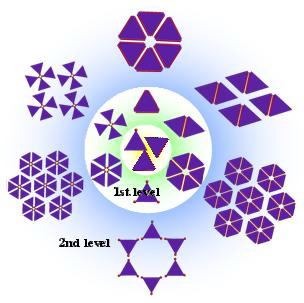Upon invitation of Royal Society of Chemistry, a tutorial review entitled “Hierarchical construction of self-assembled low-dimensional molecular architectures observed by using scanning tunneling microscopy” was recently published on Chem. Soc. Rev. (Chem. Soc. Rev., 2009, 38, 2576). Hierarchical molecular assembly has drawn increasing interest in recent years because of the possibility of fabricating highly ordered functional superstructures from elemental building units, and the building units can be ranged from DNA, peptides, -conjugated molecules, block copolymers, and nanoparticles, to organic-inorganic hybrid systems. This tutorial review reflected the progress in constructing functional low-dimensional molecular nanostructures on surfaces through hierarchical self-assembly processes. Hierarchical assembly is characterized as a multilevel process, and represented by categories depending on the nature of intermolecular interactions, symmetry characteristics, and size of the building blocks. This review will help to gain knowledge on the driving mechanism of hierarchical assemblies, and approaches on tailoring hierarchical assembly characteristics, and the designing principles for the molecular assemblies. The advances in hierarchical assembly structures could benefit the efforts towards constructing well-defined molecular architectures, which are important to the development of novel material properties and molecular devices.
Prof. Wang Chen and his group have endeavored for nearly 10 years on systematic studies on construction of low-dimensional molecular nanostructures, molecular level structural characterization, and mechanism for molecular assembly by using scanning probe microscopy. In recent years, systematic investigations on construction, tuning, and mechanism of functional molecular architectures (Macromolecules, 2007, 40, 4552; J. Phys. Chem. C, 2007, 111, 9235; J. Phys. Chem. C, 2007, 111, 17382; ACS NANO, 2007, 1, 160; J. Phys. Chem. C, 2008, 112, 8649; J. Phys. Chem. C, 2008, 112, 10141; Angew. Chem. Int. Ed., 2008, 47, 6717; J. Mater. Chem., 2009, 19, 1490), relevance between surface assembly and bulk properties of molecular materials (J. Mater. Chem., 2007, 17, 4699; ChemPhysChem, 2007, 8, 2615), and also the external-field-responsive molecular structures and the self-assembled molecular architectures (Angew. Chem. Int. Ed. 2006, 45, 6889; Phys. Rev. B, 2007, 76, 155438; Nano Lett. 2008, 8, 1836; Nano Res., 2009, 2, 235).
Because of the excellent contributions in this field, Prof. Wang has been invited to contribute several review articles in different journals, such as Curr. Opp. Colloid and Interf. Sci., J. Mater. Chem. and Int. J. Nanotechnology. (Curr. Op. Colloid and Interf. Sci., 2009, 14, 135; J. Mater. Chem. 2008, 18, 2074; Int. J. Nanotechnology, 2007, 4, 4). This research field is financially supported by National Basic Research Program of China from Ministry of Science and Technology, National Natural Science Foundation of China, and Chinese Academy of Sciences.
Contributors:
CAS Key Laboratory for Nanocharacterization
CAS Key Laboratory for Biological Effects of Nanomaterials & Nanosafety

Hierarchical construction of self-assembled low-dimensional molecular architectures
Prof. Wang Chen and his group have endeavored for nearly 10 years on systematic studies on construction of low-dimensional molecular nanostructures, molecular level structural characterization, and mechanism for molecular assembly by using scanning probe microscopy. In recent years, systematic investigations on construction, tuning, and mechanism of functional molecular architectures (Macromolecules, 2007, 40, 4552; J. Phys. Chem. C, 2007, 111, 9235; J. Phys. Chem. C, 2007, 111, 17382; ACS NANO, 2007, 1, 160; J. Phys. Chem. C, 2008, 112, 8649; J. Phys. Chem. C, 2008, 112, 10141; Angew. Chem. Int. Ed., 2008, 47, 6717; J. Mater. Chem., 2009, 19, 1490), relevance between surface assembly and bulk properties of molecular materials (J. Mater. Chem., 2007, 17, 4699; ChemPhysChem, 2007, 8, 2615), and also the external-field-responsive molecular structures and the self-assembled molecular architectures (Angew. Chem. Int. Ed. 2006, 45, 6889; Phys. Rev. B, 2007, 76, 155438; Nano Lett. 2008, 8, 1836; Nano Res., 2009, 2, 235).
Because of the excellent contributions in this field, Prof. Wang has been invited to contribute several review articles in different journals, such as Curr. Opp. Colloid and Interf. Sci., J. Mater. Chem. and Int. J. Nanotechnology. (Curr. Op. Colloid and Interf. Sci., 2009, 14, 135; J. Mater. Chem. 2008, 18, 2074; Int. J. Nanotechnology, 2007, 4, 4). This research field is financially supported by National Basic Research Program of China from Ministry of Science and Technology, National Natural Science Foundation of China, and Chinese Academy of Sciences.
Contributors:
CAS Key Laboratory for Nanocharacterization
CAS Key Laboratory for Biological Effects of Nanomaterials & Nanosafety

 Close Page
Close Page- Text Size: A A A
 Printer Friendly
Printer Friendly
